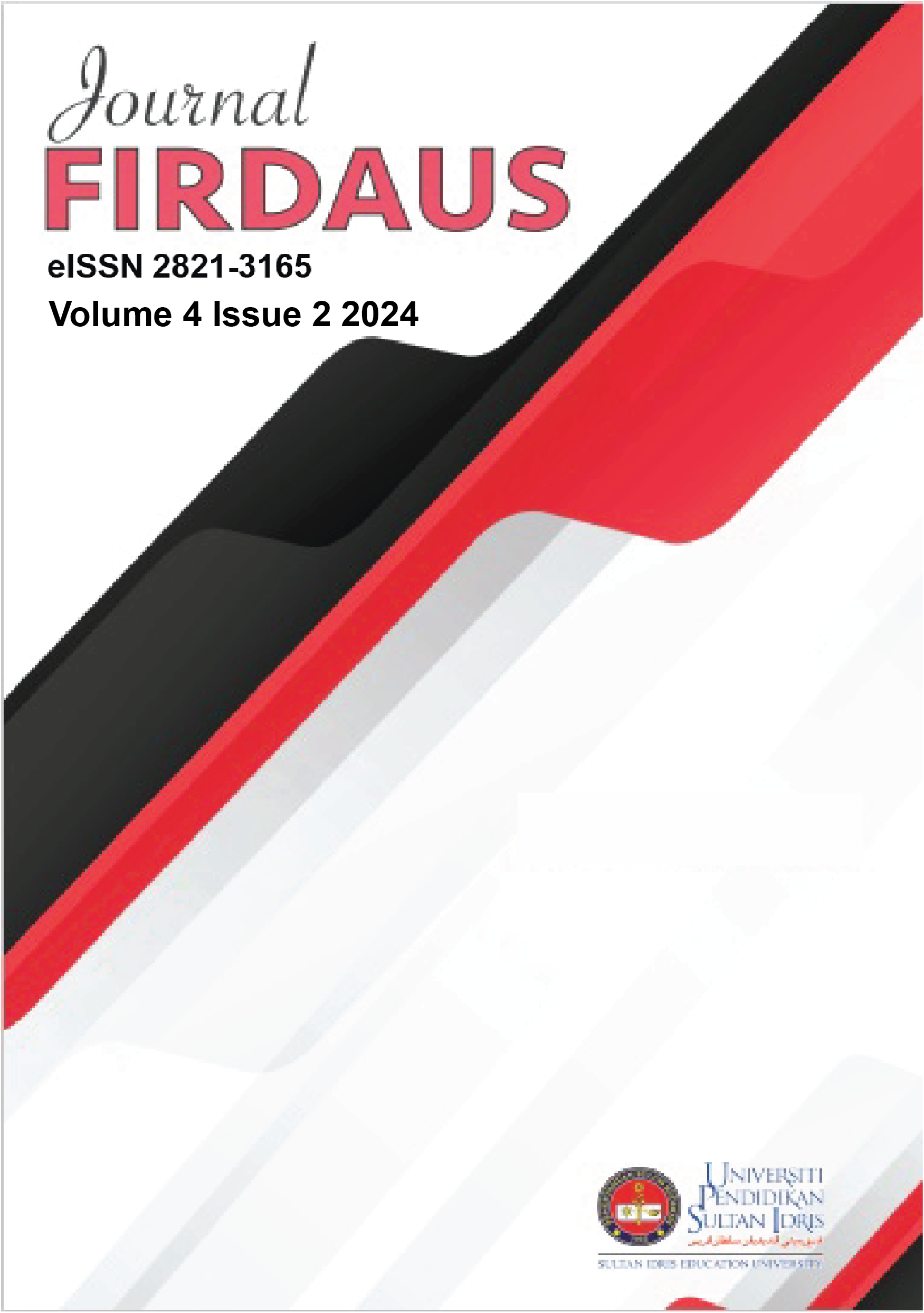An analysis of selected variables in academic Tahfiz education across the standard secondary school curriculum
DOI:
https://doi.org/10.37134/firdaus.vol4.2.1.2024Keywords:
Analysis, Selected Variables, Hafazan” Proficieny, Academic Proficiency, Personal Quality, Curriculum, Co-curricular, Blessing, Arabic language, “Hafazan” or memorization mastery, Academic TahfizAbstract
This is a phenomenological study involving separate group interviews between teachers and students. The instrument for students was used to collect quantitative data. The items were grouped according to 10 identified constructs. A total of 4 research objectives were determined. The data analysis process used multiple regression statistics with the stepwise method. The reliability of the items ranged from 0.755 to 0.786 Cronbach's alpha if items were deleted. The study's findings showed that good “Hafazan” or memorization mastery recorded a mean score of 4.10 (SD=0.81). The aspects of Arabic language translation and writing standards were at a moderate level, with mean scores of 3.23; SD=0.96: SD=0.89), respectively. Meanwhile, the aspect of communication in Arabic showed a weak ability with a mean score of 2.65 (SD=1.0). The study's findings indicated that Arabic language was the highest contributor, with 15.10 percent towards “Hafazan” or memorization mastery, and personal quality of students also contributed 6.90 percent. For the Academic Proficiency variable, the personal quality attribute emerged as the highest contributor at 8.70 percent compared to the catalyst variable at 4.20 percent. Comparatively, the personal quality variable played a dominant role in contributing to both “Hafazan” Proficiency and Academic Proficiency. Therefore, when variables were regressed on 8 independent variables, it showed that 4 variables, namely co-curricular, blessings, curriculum, and Arabic language, contributed 14.80 percent, 8.30 percent, 6.30 percent, and 3.70 percent, respectively. Hence, the personal quality of students is a primary predictor determining the success of “Hafazan” Proficiency and Academic Proficiency. The significant factors contributing to personal quality are co- curricular, blessings, curriculum, and Arabic language, ranging between 3.70 – 14.80 percent. Thus, the personal quality factor of students needs to be nurtured and developed psychologically by all teachers in the Academic Tahfiz teaching process in all schools.
Downloads
References
Ahmad Ali (2024). Kesediaan Guru dan Kecekapan Penggunaan Bahan Bantu Mengajar Sebagai Pemangkinan Dalam Meningkatkan Prestasi Murid. Universiti Pendidikan Sultan Idris, Tanjung Malim.
Ahmad Zaki (2018). Effectiveness of Integrated Curriculum in Tahfiz Schools: A Case Study in Malaysia. Universiti Malaya, Kuala Lumpur
Arnieyuzie Mohd. Arshad (2015). Ulasan Sistematik: Program Ulul Albabn dalam Sistem Pendidikan di Malaysia. Jurnal Kurikulum dan Pengajian Asia Pasifik, Vol.3, Nombor 4 halaman 22 – 35.
Farhana Tahseen dan Amir Marzuki (2018). Kajian hubungan antara Lima Faktor Besar Dengan Prestasi Akademik Pelajar Universiti di Malaysia. International Journal of Educational Research.
Heddeson. J dan Fisher. M, (1993). SPSS Made Simple. Cetakan kedua Wadsworth Publication. https://www.irujukan. My/ulul-albab-mrsm-sbp-tmua (2024)
Institut Pendidikan Islam Nasional (IPIN), (2019). Infrastructure and Technological Barriers in Islamic Schools: Impacts on Teaching and Learning.
Islamic Education Development Foundation (IEDF), (2021). Optimizing Learning Time in Tahfiz Academic Institutions: Strategies and Outcomes. Kajian NGO Pendidikan Islam.
Imam Muhammad Ibn Majah (Abad ke 9). Hadith susunan Ibn Majahno 224, dalam Book of Sunnah.
Kementerian Pendidikan Malaysia (2021). Akta Pendidikan 1996. Peraturan-peraturan Pendidikan (Penggal, Hari dan Cuti Sekolah) 1998, Pindaan 2021.
Kementerian Pendidikan Malaysia (2021). Laporan Jemaah Nazir Sekolah Persekutuan tentang pemeriksaan penuh Sekolah Harapan Negara.
Maria Montesorri (1949), Kajian tentang perkembangan kanak-kanak mengenai konsep mind spongy, dalam buku bertajuk The Absorbent Mind.
Muhammad Sayuti Sahdan dan rakan UM, (2022). Pengajaran dan Pembelajaran Al-Quran Terhadap Pelajar Pekak Di Kolej Vokasional. Journal…. Isu Dalam Pendidikan 44,2022.
Pemuafakatan Badan Ilmiah Nasional (Pembina) (2008). Tahap Kompetensi Guru Dalam Pengajaran dan Pembelajaran Sains dan Matematik Menggunakan Bahasa Inggeris Serta Implikasinya Terhadap Pembangunan Modal Insan. UPM, Serdang, Selangor.
Sekolah Maahad Tahfiz Negeri Pahang (2024). Persediaan Jadual Waktu Persekolahan sesi 2024. Kuantan, Pahang.
Kurikulum Standard Sekolah Menengah Tahfiz (KSSMT), (2023) Kementerian Pendidikan Malaysia.
Downloads
Published
Issue
Section
License
Copyright (c) 2025 Idris Jusoh, Mohd. Sahandri Gani Hamzah, Wan Zakri Wan Kamaruddin, Norazilawati Abdullah, Sakinah Salleh, Abdul Halim Sulong

This work is licensed under a Creative Commons Attribution-NonCommercial-ShareAlike 4.0 International License.





